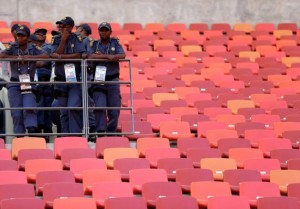
Guest Post by Marc Fletcher* (cross-posted with permission of Africa is a Country and the author.)
One of the key sights of this year’s Africa Cup of Nations has been emptiness. Aside from the opener between South Africa and Cape Verde, the television cameras have picked up images of large swathes of empty seats. Whether it was Burkina Faso’s last gasp equalizer against Nigeria in Nelspruit or Tunisia’s equally late winner versus Algeria in Rustenburg, the empty seats appeared to outnumber the fans that had made the trip. Coverage from previous editions of the tournament in Ghana, Angola and Equatorial Guinea picked up similar images. This is clearly not a South African-only problem.
I had earlier hoped that the more reasonable pricing structure for this tournament as opposed to the 2010 World Cup would have made the games more accessible to majority of poorer, working class football fans; those who make up the vast majority of the support base of South Africa’s domestic clubs. The empty seats suggest that it’s reaching few people in general.
So what are the issues behind this?
Firstly, there aren’t many players in this tournament that can be described as superstars. In the World Cup, there was Messi, Ronaldo and the entire Spanish squad. This time around, there’s Didier Drogba, whose career is winding down in China but few others. Yes, there are players such as Yaya Touré and Asamoah Gyan but they simply do not have the same star status. Why spend hard-earned money to watch two teams that you have little or no interest in?
Secondly, the 5 pm kick off times are hardly conducive to getting bums on seats. As I write this, I have one eye on the Bafana v Angola match. While attendance seems to be significantly greater than in most of the other matches, there are still many empty seats. Traffic at this time in the major cities can be nightmarish and some fans will be unwilling to put themselves through the gridlock and confusion. To make sure that you get to the stadium in plenty of time means taking the afternoon off work.
A big contributory factor is that that there are few, if any African countries that have a large fan base with a large enough disposable income to fly out to the southern tip of the continent for the tournament. Unlike the vast hoards of traveling football tourists at the Euros or at the World Cup, the support of visiting teams is usually restricted to a small rump of die-hard regular fans who are sometimes subsided by the state or political parties. While the commitment on the part of these fans is impressive, this is not going to fill these former World Cup venue. This is a problem that is not going to go away anytime soon.
But the thing that strikes me most as I write from Johannesburg is the absence of evidence that the tournament is taking place. In 2010, there were numerous posters around the city, large fan parks with big screens and people blowing vuvuzelas on street corners. Thousands crammed onto the streets in the north of the city when Bafana went on an open-top bus tour while a giant photo of Cristiano Ronaldo was emblazoned on Nelson Mandela Bridge. This time, it is severely underwhelming. There is no party atmosphere, no fan parks, little hype on local television or radio. Bafana shirts are far less apparent on the street in contrast to 2010. It’s not totally absent though. Staff at my local Spar were wearing their Bafana shirts today, while bar staff on Soweto’s tourist strip on Vilakazi Street were doing the same.
Still, it’s as if the tournament has passed Jo’burg by and I wouldn’t be surprised if it passes most of South Africa by with little more than a passing awareness that Africa’s biggest football tournament is in their country. The slogan of the tournament is “The beat at Africa’s feet,” but this beat is strangely subdued.
Maybe people realize that they have more important things to do than watch football?
N.B. During the South Africa vs Angola match, Moses Mabhida stadium in Durban seemed to be fuller in the second half. The commentator on Supersport (the South African satellite channel that dominates football broadcasting on the continent) has suggested that there is an excessive number of security cordons, which has delayed many fans from getting into the ground until the latter part of the first half.
* Marc Fletcher (MarcFletcher1), a postdoctoral fellow at the University of Johannesburg, blogs at One Man and His Football: Tales of the Global Game.
Tag: Durban
Quarterfinals at the Beach
The ‘real’ World Cup at the beach in Durban, where we watched the quarterfinals. Mabhida stadium made by local sand sculptors, kids playing beach football, and the game on the big screen. How most South Africans and a few visitors experienced South Africa 2010.
I’m still in disbelief that BaGhana BaGhana came within a PK of making history as Africa’s first World Cup semifinalist. Impressed by ‘Rainbow Nation’ Germany‘s humiliation of Maradona’s Argentina. Pleased that efficient Netherlands overcame Dunga’s unimaginative Brazil. And thrilled that MaraVilla’s Spain took care of overachieving Paraguay. Commentary and semifinal preview forthcoming.
zzzzzzzzzzzzzzzz . . . Robben! zzzzzzzzzzzzzz . . . Sneijder! zzzzzzzzzzzzzzzzzzzzzzzzzzzzzzzzzz . . .
That’s my match report from Durban’s Mabhida Stadium where the Dutch easily dispatched the Slovaks 2-1. The best of the rest of our experience is captured in the short video above.